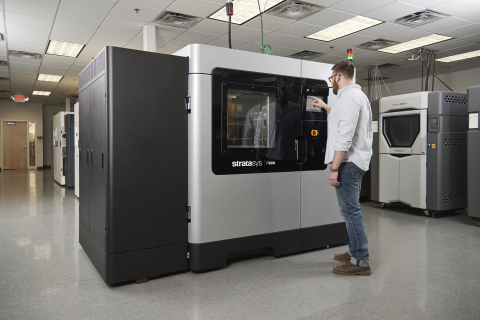As discussed in our recent 3DPrint.com PRO article, 3D printing is seeing increasing use in military applications, which is the obviously the largest sector for government spending in the U.S. and many other nations. This means that those users of the technology will also be concerned with maintaining cybersecurity of their 3D printers, designs and everything along the manufacturing workflow. Stratasys (NASDAQ: SSYS) is one firm looking to cater to military and government clients, having just announced a new data security solution for improving additive manufacturing related cybersecurity.
Dubbed ProtectAM, the platform relies on Red Hat Enterprise Linux, already chosen by the U.S. government as a means of delivering continuous information processing security based on the Security Technical Implementation Guide (STIG) issued by the Defense Information System Agency (DISA) of the U.S. Department of Defense. ProtectAM, too, was created to comply with the STIG for Red Hat Enterprise Linux, which delineates hundreds of security controls related to cybersecurity protection.
ProtectAM will first be available for a variety of industrial and large-format Stratasys fused deposition modeling (FDM) 3D printers. These machines are in use by government clients to 3D print end-use parts and tooling for aviation and ground maintenance, among other applications. Beginning October 1, the Fortus 450mc will be eligible for use with ProtectAM and Stratasys aims to extend this to the F900 by the end of 2021. The Stratasys F370 and F770 machines will be added in Q1 2022 before the company introduces the platform to non-FDM systems. Later on, Stratasys aims to add ProtectAM to non-government sectors, as well.
“The benefits of 3D printing are clear, including getting critical products wherever they are needed, with maximum speed and minimal cost, all while extending the lifespan of existing assets to save taxpayer dollars,” said Dick Anderson, Senior Vice President for Manufacturing at Stratasys. “Furthermore, the integrity of parts printed from digital files is absolutely essential, and we have established the ProtectAM solution to be a world-class security solution to continue the adoption of additive manufacturing by government agencies, and ultimately to commercial segments as well.”
ProtectAM allows Stratasys 3D printers to work in applications that were previously not available. This includes the ability of the U.S. military to use a distributed 3D printer network globally. The platform is built on the FIPS and Common Criteria government-certified foundation of Red Hat Enterprise Linux. This means that mission-critical digital files can be sent anywhere and 3D printed locally.
“Software security is a front-and-center challenge for nearly every government agency, and a need that Red Hat helps to address through our extensive work in certifying the world’s leading enterprise Linux platform to meet stringent public security requirements,” said David Egts, Chief Technologist, North America Public Sector, Red Hat. “Red Hat Enterprise Linux provides a platform that assists users in meeting the rigorous software security needs for sensitive computing without sacrificing flexibility, scalability or innovation. We’re pleased to be able to provide this as a foundation for Stratasys as they work to innovate industrial 3D printing and additive manufacturing in the public sector.”
The news follows a recent audit by the Pentagon’s Office of Inspector General that determined the U.S. military’s 3D printing operations lack the proper cybersecurity. The report noted that “if malicious actors change the AM design data, the changes could affect the end strength and utility of the 3D printed products.” It further determined:
“The need to update operating systems is critical to protecting the AM computers and the printers connected to them. For example, in 2019, Microsoft issued over 197 operating system updates to fix security vulnerabilities, one of which fixed a vulnerability that allowed attackers to gain unauthorized access to a single computer and then use that access to log into other computers.”
Stratasys’ response was a quick one, indicating that it had already been working on the new platform. Presumably, other manufacturers will offer their own cybersecurity solutions, as well. This also indicates that 3D printing is moving beyond the trial phase by the U.S. military and will see more live deployment.
Subscribe to Our Email Newsletter
Stay up-to-date on all the latest news from the 3D printing industry and receive information and offers from third party vendors.
You May Also Like
3D Printing Unpeeled: New Arkema Material for HP, Saddle and Macro MEMS
A new Arkema material for MJF is said to reduce costs per part by up to 25% and have an 85% reusability ratio. HP 3D HR PA 12 S has been...
3D Printing News Briefs, January 20, 2024: FDM, LPBF, Underwater 3D Printer, Racing, & More
We’re starting off with a process certification in today’s 3D Printing News Briefs, and then moving on to research about solute trapping, laser powder bed fusion, and then moving on...
3D Printing Webinar and Event Roundup: December 3, 2023
We’ve got plenty of events and webinars coming up for you this week! Quickparts is having a Manufacturing Roadshow, America Makes is holding a Member Town Hall, Stratafest makes two...
Intuitive Machines Debuts $40M Hub for Lunar Ambitions and 3D Printing Tech
Best known for its pioneering work in lunar exploration and its development of the Nova-C lunar lander, Intuitive Machines (Nasdaq: LUNR) has marked yet another significant milestone. The leading space...

































